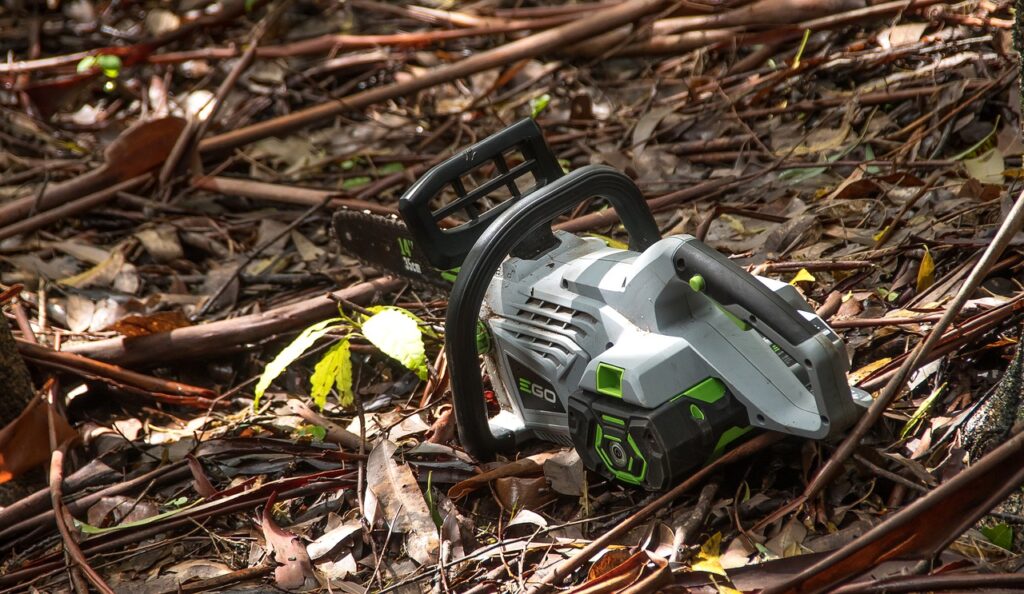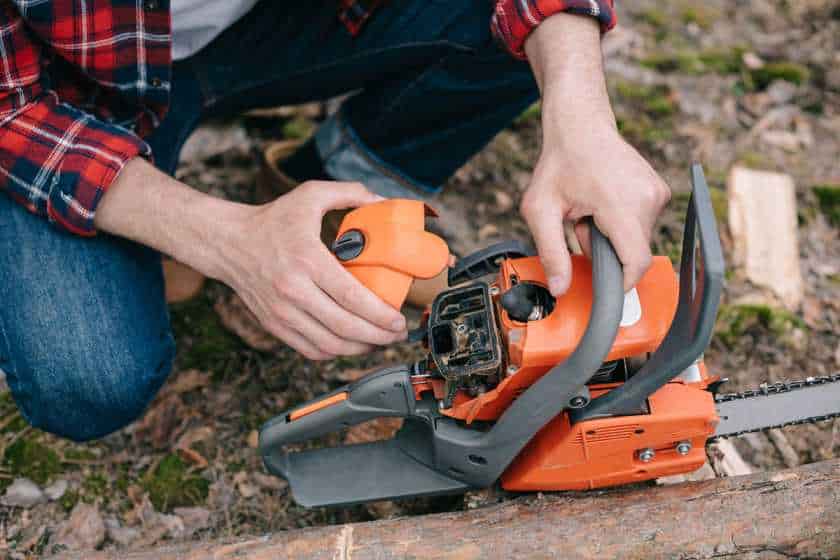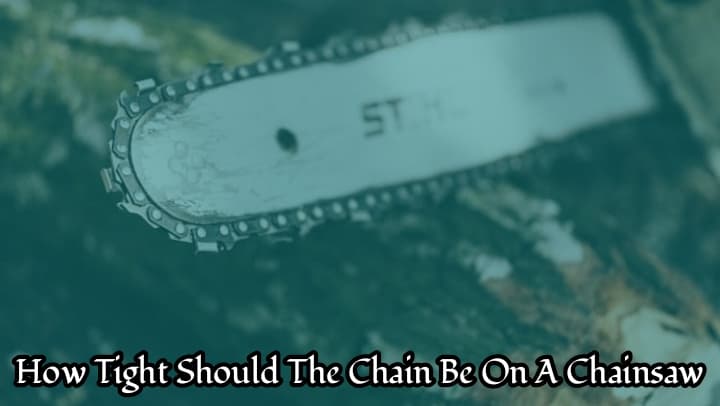If you are looking for an answer to the question of how tight should the chain be on a chainsaw, you might find yourself wondering what is the correct tension for chainsaws. As with any tool, there are procedures that need to be followed in order to ensure safety and maximize power put out by your chainsaw.
There is some controversy over the right way to adjust a chainsaw chain. There are two common methods commonly used. The first method uses the ‘length of the teeth’, while the second uses how tall or deep the cut you desire. Here are some tips on how tight the chain should be on a chainsaw.
Table of Contents
Method 1: Pull the Rivets Apart
The first method states that if you can pull two adjacent rivets apart (the rivet at one end of the chain and the rivet immediately to its right) with your bare hands easily, then your chain is adjusted correctly to length. You also need to make sure there is an equal amount of slack as you move from link to link around the bar, as well as check all links for full articulation.
If the chain is too tight, you’ll start to notice it climbing up on the bar during cutting action. When this happens, you’ll actually see tooth marks showing on your bar and if your cut was particularly deep (you were perhaps trying to cut too big a branch), then you might even recognize that it has nicked the bar itself.
The next time you adjust the chain, tighten so there’s just enough slack for two rivets to be pulled apart by hand, plus one link extra at each end of the bare.
Method 2: Gap Approximation
The second method states that there should be an approximate 1/8″ gap between the underside of the guide bar nose and the top side of drive links when viewed from above with tensioners correctly adjusted.
This 1/8″ gap is the depth of cut for a low-kickback chain, and if your bar doesn’t have any markings for this purpose, then 1/8″ is also the depth of cut you’ll want to shoot for when cutting wood.
To verify your depth of cut, take a piece of straight scrap timber or other objects about 12″ long which has a flat surface at both ends, and measure down from one end with a tape measure until it touches the top side of the guide bar nose.
The difference between this measured distance and 7-1/4″ (or whatever the nominal length of your bar without chain) will be how deep you can safely allow your saw to bite into the wood as you make cuts.
Then simply adjust your chain tension until you have exactly 1/8″ clearance between the top of the guide bar nose and the underside of the drive links. This method will work for all styles of chainsaw except low profile or low-kickback, which are adjusted to length by the previous method.[1]
If your saw vibrates excessively when idling, stumbles upon starts, rides upon the wood being cut, or if the engine tends to stall while cutting hardwood, then it’s likely that your chain is too tight.
If this is your case then you may need to loosen your chain a tiny bit in order to fix these problems – but only very slightly, just enough so there are no more than two rivets apart at any one link.

How to Maintain Tension Best?
Though either of these methods will work, the best way to maintain tension is to use sawdust. Replacing your chain when it becomes dull rather than trying to sharpen it yourself saves time and money, but if you find that there’s still enough life in the old one then you can keep an eye on how much tension is generated in order to tell if it needs replacing.
If you see sawdust building up in front of the bar (from top side down) when your engine is running at idle speed – without any load on the saw – then this shows that the chain has proper tension and is not about to break or jump off; conversely, if no dust accumulates during idling with normal usage (on the first cut of a fresh day), then the tension needs to be adjusted accordingly.
Keep an eye on your bar and drive links as well: if they start to show signs of wear and discoloration, or if they become damaged in some way, then you’ll need to replace them before another cut is made.
How Tight Should The Chain Be On A Chainsaw?
That would depend upon two factors – firstly how long your guide bar is without a chain, allowing for rivet spacing plus one more at each end; secondly how deep you intend to cut into hardwood with that same new sharpened chain.
If it’s only going to do light daily chores around the yard, your saw will probably operate fine with a 1/8″ gap between the top side of the guide bar nose and underside of drive links. If you’re a professional using your saw daily, then a 5/32″ gap is probably better to help reduce chattering and kickback on deep cutting.
A new chain should have about 1/8″ slack between guide bar nose and drive links when viewed from above with tensioners correctly adjusted, but only slightly more than this if it’s an older chain being reused after having been removed for sharpening.
Different chains may need more or less tension applied depending upon the style of saw they are fitted to – low profile or low-kickback being particularly sensitive – so it’s advisable to check the manufacturer’s manual before attempting any adjustment to these chains.
Chain breakage can be dangerous; therefore it’s vital that you maintain your chain at all times to avoid tragedy. Sharpening a chain takes time and expertise, so it’s best left to the professionals, but if you do feel confident enough to attend to this yourself then regular viewing and critical inspection of your sharpened chain should be part of your maintenance schedule.
It is important that you know how tight your chain is. If it is too loose, it can fly off and hit you on your shin or elsewhere. This could be a serious injury that would require medical attention. If you have a guide bar on your chainsaw, then you will see a symbol of a screwdriver with an up arrow coming out from behind the handle.
The Following Will Tell You What Those Numbers Mean:
If the screwdriver points straight up, as shown in number one, this means the saw is at its loosest setting. In order for it to tighten up so that, as shown in number two, you must turn clockwise until both numbers are lined up. When they’re lined up properly, it tells you the saw is going to be at its tightest setting.
If you have a guide bar on your chainsaw, this will tell you how much slack there is in the chain, and can either get too loose or too tight. [2]
There should never be an excessive amount of slack (too loose) in the chain because it could fly off and hit you somewhere on your body or your saw’s motor could seize up from lack of tension altogether. If it’s too tight, then it won’t run efficiently and wear out faster than it needs to.
If you don’t have a guide bar, (also called a raker), on your chainsaw, then you will see an L-shaped symbol with an arrow coming out from behind the handle. If the arrow is facing forward, as shown in number one above, then your chain is at its loosest setting. If you want it to be tighter than that, then you will need to turn clockwise until both numbers line up. Once they’re lined up properly, this tells you that the settings are now at their tightest.
If your chain isn’t running efficiently or has become too loose after using it for a long time, ask yourself if either of these problems sounds familiar: The chain comes off while you are working. The saw’s motor sounds noisy or rough which could indicate that there’s not enough tension on the chain so adjust accordingly.
You should always check your chainsaw before you begin work and readjust once everything is done. Once you start working, keep in mind that it can be easy for the chain to get loose which means that if you are cutting into something too big for your saw’s bar or are leaning on the saw when it is trying to cut, the chain could come off and hit you in someplace dangerous.

What’s The Best Way To Determine Whether Or Not A Chain Is Too Loose Or Too Tight On A Chainsaw?
There are two methods that work well for determining proper tension.
Push Up On The Drive Link
The first, and easiest, is to push up on the drive link about halfway between the bar and the sprocket (on most saws).
If you can move it more than 1/16″, your chain needs tightening. If you can move it less than 1/16″ but more than 1/32″, your chain may be okay for now, but I’d tighten it anyway.
Inertia-Type Gauge
The second method for checking tension involves using an inertia-type gauge like this one. It works by allowing you to pull down on the guide bar while measuring how much weight is required to accelerate the bar to a given speed in a given time. The faster it moves and the more acceleration it takes, the looser your chain is.
Your saw will be perfectly tuned if you can achieve a tension reading of between 13.9-15.9 pounds using this method with all drive links in place on the saw at room temperature (68° F).
Once you have the ideal tension tighten the knob of your chainsaw by hand and then with a wrench to ensure that it remains at this tightness. Remember, if you’re still having problems with loose chains try tightening further or considering replacing your current chain.
Final Verdict
The best way to determine how tight the chain on your chainsaw should be is to go by feel. The chain should make a “U” shape around the bar, and it should not sag in any area of the “U”. If you can fit more than two fingers between the top of the bar and the quick link or chain then your chain is too loose.
If the chain is really tight (depending on your brand of chainsaw this may be up to two fingers) you should loosen the bar nuts and reset the chain by moving it closer to each side of the bar so there is no more than one finger between the top of the bar and the quick link or chain. Also, if you are cutting in the cold weather, you should always loosen your bar nuts and allow the chain to move on the bar.

